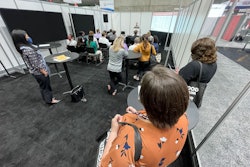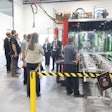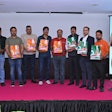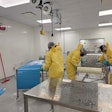Kormotech has updated one of the fundamental tools of Lean management--"5S"--Workplace Organisation. It is used for the continuous improvement of working conditions. All employees in production, as well as employees of auxiliary services and related departments are involved in the process.
Lean is a methodology for delivering maximum value to the client through minimization of losses and continuous improvement. This is an effective management concept recognized by many international companies, which is aimed at optimizing business processes by maximizing focus on the interests and needs of the client (market) and motivating each employee.
The implementation of the Lean-production methodology allows us to solve several main challenges that most enterprises face every day: achieve high quality with minimal costs, reduce the production time, avoid overproduction, reduce stocks in the lines (raw materials, finished products) and improve customer service level. In addition, this improves work safety and workplace comfort for each employee, as well as employee involvement and motivation.
The author of the concept is Taiichi Ohno, who developed a unique production system for Toyota Corporation–Toyota Production System (TPS), called Lean Production in Western countries. Even Henry Ford once tried to convey the principles of Lean Production to the business community. However, his ideas were not embraced then. By being the first in the world in introducing Lean-production methodology, the Japanese once again demonstrated their talent, not so much to generate new ideas as to develop the existing ones.
Currently, Kormotech is developing the 5S initiative, one of Lean Management tools. Previously, some mechanisms of the 5S system were introduced in the Kormotech culture, but now, the team has decided to activate it to its full potential and create a basis that will be the foundation of the entire corporate culture of the company. The pilot project will be our production plant in Ukraine, and then in Lithuania.
Depending on the type of company, each team chooses the tools that they will deploy. After all, there are many of them, but some are basic, key tools. Usually, companies choose a few that they work with in the future. Some tools are launched first, then others are added as support tools, working in a pair in the future. After a while, more tools are added and so on. This is the continuous improvement tendency.
The pace of implementation of Lean-management tools depends on the cultural characteristics of each of the regions where the company's production and offices are located. Thus, one tool can be implemented faster, and the other not. This is influenced by the cultural characteristics of the country. It is important to note that, for example, in Japan, this system is in place since kindergarten, whereas for Ukraine, it is a tool that has been borrowed.
Expectations and indicators
"It is not right to look at the numbers if we plan to build a culture, to encourage the team's desired behaviour. We aim to create a self-improving system. It will determine its own goals and constantly improve. This is a long process that takes time.
Now we are building a foundation based on the 5S system, adding tools that will change the culture and, only after that, we will see the first results. We will try to integrate the system in the next 5 years and reach the first indicators," said Igor Paranyak, production director of Kormotech Ukraine.
“Not all employees are ready for change. But there is a certain percentage of them who, on their own initiative, are ready to change something. There are also some observers who will look in which direction the company is moving, subsequently choosing one side or another. In my opinion, it will be possible to talk about a successfully implemented project when we move to other positions, yet everything will continue to live independently. This is exactly what the process of continuous improvement means," said Roman Odynets, operations manager.
Key directions and focuses on the implementation of the Lean-production concept for the current period:
- training of employees in the tools of Lean Production. Already more than 70% of all employees have undergone such training on 5S, scheduled maintenance of equipment, fast recalibration. The goal is to reach all 100% of employees in giving them theoretical and practical knowledge.
- thrifty use of energy resources. This is especially important in times of energy crisis; it involves the European Bank for Reconstruction and Development energy audit program to assess energy efficiency and obtain a map of the opportunities we will implement using Lean tools and philosophy. Successfully implemented projects include heat recovery from technological processes; cleaning and reuse of vapour condensate; transition to renewable electricity–80% of energy used by our production in Lithuania comes from wind energy.
Lean-production principles will form the basis for the sustainable development of Kormotech, which, in turn, will help the company reduce its environmental impact.












